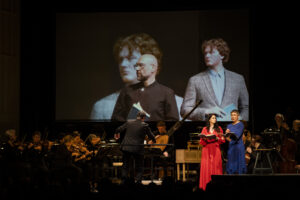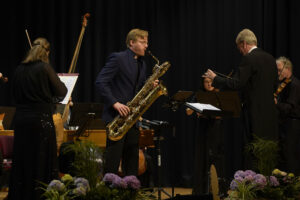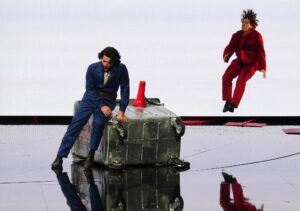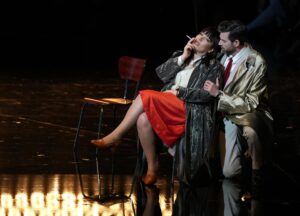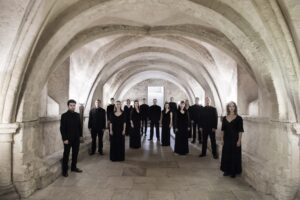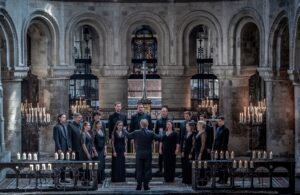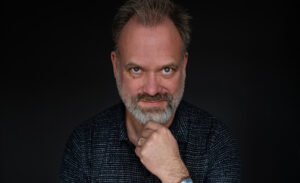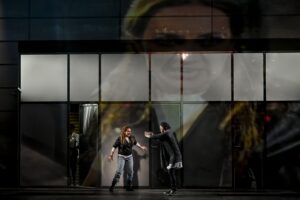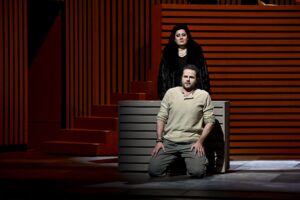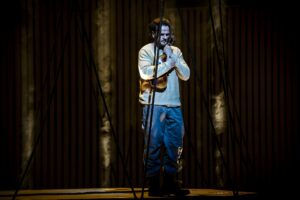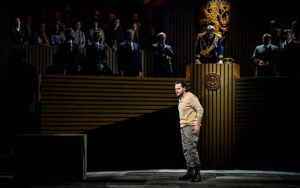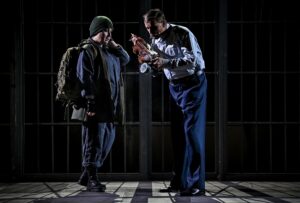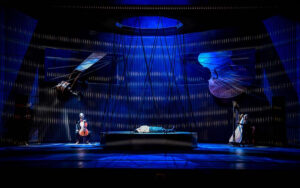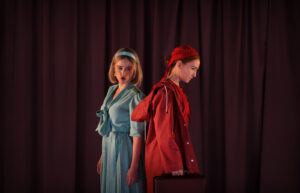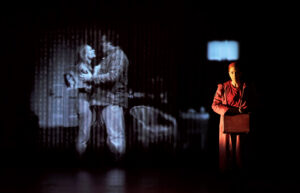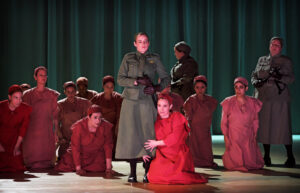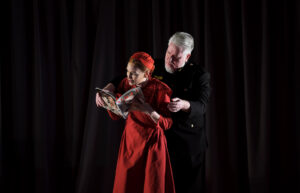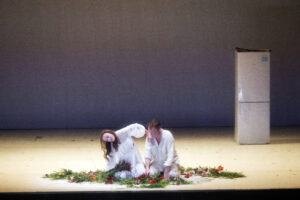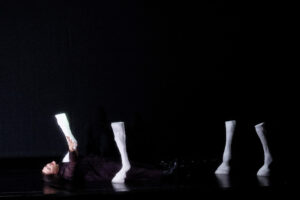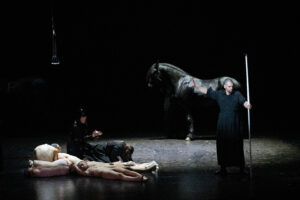Mroczna czułość sarabandy
Agatha Christie powiedziała kiedyś, że przeczytane książki wracają do nas w sposób niezwykły. Podobnie bywa z muzyką. W zeszłym roku dotarłam do Getyngi wprost z Wenecji, po inscenizacji Il trionfo del Tempo e del Disinganno w Teatro Malibran – i nie spodziewałam się, że pojedyncze arie z tego oratorium będą do mnie wracały nie tylko na Festiwalu Händlowskim, ale też kilka miesięcy później na Bayreuth Baroque. W tym sezonie zamierzałam pojawić się na końcówce getyńskiego święta, ale musiałam zmienić plany i zjechałam na pierwsze trzy dni imprezy – zainaugurowanej właśnie Il trionfo w wykonaniu solistów oraz FestspielOrchester pod kierunkiem George’a Petrou. „Lascia la spina” znów wróciła do mnie nazajutrz. I to niejeden raz. W sposób tyleż niezwykły, ile nieoczekiwany.
Tegoroczna inauguracja odbyła się w świeżo odnowionej Stadthalle na skraju miejskiej starówki. Przyszłość potężnego gmachu, wzniesionego na początku lat 60. według projektu Rainera Schella, jeszcze niedawno wisiała na włosku. Budowla była w fatalnym stanie technicznym. Część mieszkańców do tej pory nie oswoiła się z jego modernistyczną estetyką: przede wszystkim z nietypową elewacją z opalizujących płyt ceramicznych, której Stadthalle zawdzięcza złośliwy przydomek „pieca kaflowego”. Pojawiły się wątpliwości, czy odsłonięcie azbestowych elementów konstrukcji w trakcie renowacji nie stworzy zagrożenia dla zdrowia ludności. Prace remontowe przedłużyły się w związku z pandemią i zamknęły w kwocie przeszło dwukrotnie wyższej niż planowano. Głosy krytyki nie milkły nawet po uroczystym otwarciu Stadthalle w styczniu 2024 roku. Specjaliści utyskiwali między innymi na wady akustyczne sali koncertowej, których mimo kosztownych zabiegów nie udało się zniwelować w przestrzeni odtworzonej zgodnie z pierwotnym założeniem architektonicznym.
Nie da się ukryć, Musikverein to nie jest, i wielbiciele XIX-wiecznej symfoniki z pewnością mają prawo czuć się rozczarowani. Händlowskie oratorium z udziałem niewielkiej orkiestry i czworga solistów zabrzmiało jednak w Stadthalle wystarczająco selektywnie i przejrzyście, by słuchacze mogli w pełni docenić puls, emocje i dramaturgię tego młodzieńczego arcydzieła. Wykonanie zostało dyskretnie wyreżyserowane przez Ilkę Seifert, asystentkę Sashy Waltz przy warszawskim spektaklu Matsukaze Hosokawy, wspartej przez innych współpracowników niemieckiej choreografki: Folkerta Uhdego, twórcę symbolicznych, nierozpraszających uwagi projekcji wideo, oraz odpowiedzialnego za światła Jörga Bittnera. Na nic jednak zdałyby się ich starania, gdyby nie przemyślana interpretacja Petrou, który zdecydował się na wyjątkowo trudny – i po mistrzowsku zrealizowany przez muzyków – zamysł stopniowego, niemal niezauważalnego spowalniania narracji aż po ostateczne „zatrzymanie czasu”. FestspielOrchester Göttingen, założona w 2006 przez Nicholasa McGegana, który uwzględnił w jej składzie instrumentalistów związanych od dawna z festiwalem, dorównuje poziomem najlepszym zespołom barokowym w Europie. Petrou umie nie tylko zestroić ją w jednobrzmiący organizm, ale też dać pole do popisu poszczególnym wirtuozom (na czele z fenomenalną oboistką Susanne Regel, obdarzonym wyjątkowym wyczuciem stylu organistą Fernandem Aguado oraz koncertmistrzynią, o której za chwilę). Świetnie też współpracuje ze śpiewakami, którzy stworzyli przekonujący kwartet „żywych” alegorii – mimo niespodziewanej zmiany w obsadzie partii Bellezzy.
Il trionfo del Tempo e del Disinganno. W głębi na ekranie Xavier Sabata (Disinganno) i Emanuel Tomljenović (Tempo); na pierwszym planie Emöke Barath (Piacere) i Anna Denis (Bellezza). Fot. Alciro Theodoro da Silva
A może właśnie dzięki tej zmianie, bo niedysponowaną Louise Kemény zastąpiła zjawiskowa, także pod względem aktorskim, Anna Dennis – dysponująca wyrazistym sopranem, którego barwę potrafi cieniować, jakby mieszała pigmenty na palecie. Doskonałe wrażenie wywarła na mnie Emöke Barath w roli Piacere – sopranistka o głosie ciemnym, bogatym w alikwoty i znakomicie podpartym, co udowodniła w arii „Lascia la spina”, zaśpiewanej w wyjątkowo wolnym, „zastygającym” tempie. Zaskakująco dobrze wypadł Xavier Sabata jako Disinganno, wynagradzając pewne niedostatki blaknącego już kontratenoru mądrością interpretacji. Młodziutki Emanuel Tomljenović, obdarzony pełnym, urodziwym i świetnie ustawionym tenorem, bez trudu pokonał wszelkie trudności partii Tempo, choć akurat w jego przypadku zabrakło mi głębszej refleksji nad tekstem.
Niezależnie od walorów muzycznych wykonania, publiczność zapamiętała też piękny, a zarazem prosty zabieg reżyserki, żeby w finale Bellezza ujęła za rękę pierwszą skrzypaczkę Elizabeth Blumenstock, wyprowadziła ją z orkiestry, usadowiła na krześle z przodu sceny i zaśpiewała „Tu del Ciel ministro eletto” w tak intymnym duecie z koncertmistrzynią, by słuchacze zapomnieli o całym świecie. Kto wie, czy nie bardziej niż śpiew wzruszyła mnie stylowa gra weteranki nurtu wykonawstwa historycznego, prowadzącej smyczek po strunach instrumentu, który był już „dorosły”, kiedy Händel dopiero się rodził.
Nazajutrz po olśniewającej inauguracji przenieśliśmy się do Deutsches Theater, gdzie rokrocznie odbywa się premiera nowej inscenizacji którejś z oper patrona festiwalu. Tym razem organizatorzy sprawili niektórym bywalcom niespodziankę, włączając się w coraz szerszą kampanię wskrzeszenia gatunku pasticcio. Pisałam o niej wielokrotnie, zwłaszcza w kontekście Rivoluzione e Nostalgia w La Monnaie, nie muszę więc nikogo przekonywać, jak gorąco jej kibicuję. Nie muszę też dodawać, że stworzenie dobrego pasticcia wymaga ogromnej wiedzy, nie tylko muzykologicznej; mrówczej pracy i anielskiej cierpliwości; nade wszystko zaś prawdziwej wiary w trwałość i siłę przekazu formy operowej.
Krystian Lada udowodnił, że z fragmentów oper Verdiego można złożyć spójną opowieść o rewolcie 1968 roku i jej dalekosiężnych konsekwencjach. George Petrou i Laurence Dale – znakomity tenor brytyjski, który po zakończeniu triumfalnej kariery zajął się reżyserią i dyrygenturą – podeszli do rzeczy z pozoru bardziej zachowawczo, tworząc Händlowskie pasticcio na motywach opowiadania Balzaka Sarrasine. Mało kto jednak pamięta, że drugie życie tej literackiej miniatury z 1830 roku zaczęło się właśnie w roku 1968 – od poświęconego jej seminarium Rolanda Barthes’a, który zapis swoich wykładów w paryskiej École pratique des hautes études opublikował w słynnej książce S/Z. Dokonał w niej brawurowej dekonstrukcji „logiki fabuły”, której osią jest historia młodego, zbuntowanego rzeźbiarza i jego obsesyjnej miłości do pięknej śpiewaczki Zambinelli – niechętnej nawiązaniu bliższej znajomości z artystą, który nie ma pojęcia, że obiekt jego westchnień jest w rzeczywistości pięknym kastratem.
Na słabość nowej teorii znaczeń Barthes’a wskazywała między innymi Ewa Bieńkowska, pisząc, że z lektury S/Z wyniosła raczej wrażenie obcowania z człowiekiem, dla którego „czytanie jest rozkoszą i który tej subtelnej przyjemności chciałby i nam udzielić”. Książka odbiła się jednak szerokim echem w świecie i pociągnęła za sobą falę zainteresowania zapomnianym utworem Balzaka, z oczywistych względów także wśród muzyków i ludzi teatru. Historię Sarrasine’a i Zambinelli opowiedział między innymi Neil Bartlett w głośnym niegdyś wodewilu operowym z muzyką Nicolasa Bloomfielda.
Sarrasine. Juan Sancho w roli tytułowej i Samuel Mariño jako Zambinella. Fot. Alciro Theodoro da Silva
Petrou i Dale podeszli do Sarrasine w taki sposób, w jaki Bieńkowska wyobraziła sobie kiedyś zaczytanego w Balzaku Barthes’a, który „smakuje każde słowo, przywołuje na pomoc (…) całe swoje wykształcenie, wszystkie wiadomości i skojarzenia, jakich dostarcza solidna i szeroko zakrojona edukacja”. Petrou skompilował materiał muzyczny dwuaktowego pasticcia wyłącznie z utworów Händla – fragmentów oper, kantat i oratoriów (często w wersjach alternatywnych lub odrzuconych przez kompozytora), ale też wyimków z concerti grossi – z nawracającym motywem sarabandy, która objawia się pod najrozmaitszymi postaciami, od fragmentu instrumentalnego z Almiry, przez arię „Lascia la spina” z Il trionfo, aż po pamiętną z Barry’ego Lyndona sarabandę z Suity d-moll HWV 437. Dale uzupełnił libretto dialogami francuskimi i włoskimi.
Twórcy dochowali wierności Balzakowskiej „opowieści w opowieści”, uwypuklając zarówno dwa równolegle rozwijane wątki miłosne – czyli zaloty Narratora, utożsamionego tutaj z Balzakiem, do Madame de Rochefide, oraz wcześniejsze o lat kilkadziesiąt zauroczenie Sarrasine’a kastratem Zambinellą – jak i obecne w literackim pierwowzorze zderzenia przeciwieństw: mroku z przepychem, młodości ze starością, urody z brzydotą. Pomogły w tym oszczędne, dobrze oświetlone przez Johna Bishopa dekoracje Giorginy Germanou, na których tle scenografka tym skuteczniej budowała wielowątkową strukturę narracji przy użyciu sugestywnych kostiumów. Dodajmy, że w bardzo dobrej współpracy z reżyserem, który poprowadził solistów – oraz towarzyszących im w rolach pobocznych troje aktorów Deutsches Theater – z iście brytyjską precyzją.
Główny ciężar spoczął na czworgu śpiewaków, z których odbiorcom najbardziej zapadł w pamięć Samuel Mariño w roli Zambinelli. Istotnie, jakby dla niego stworzonej: wenezuelski sopranista odznacza się nie tylko nietypowym głosem, ale też intrygującą, androgyniczną urodą, która w połączeniu z niezłym rzemiosłem aktorskim pozwoliła mu stworzyć przekonującą postać nieszczęśliwego kastrata. W przeciwieństwie do większości kolegów po fachu nie podzielam jednak zachwytów nad wokalną stroną jego popisu. Mariño dysponuje sopranem niewątpliwie urodziwym, ale niepopartym rzetelną techniką – choć z pewnością potrafi „oszukiwać” spektakularnymi, często niepowiązanymi z logiką frazy trylami, oraz innymi, nie zawsze stylowymi ozdobnikami. Wolumen ma nikły i nie umie nawet tego ukryć: na dobrą sprawę wyczerpał cały swój potencjał w arii „L’armi implora” z pierwszego aktu. Pod względem muzycznym zdecydowanie górował nad nim Juan Sancho w roli tytułowej, śpiewak, z którym zetknęłam się po raz pierwszy na żywo w ubiegłym roku w Madrycie, przy okazji premiery Achille in Sciro Corsellego. Pewien nadmiar ekspresji w jego soczystym tenorze – rażący wówczas w partii Nearco – tym razem sprawdził się doskonale jako nośnik miłosnych cierpień Sarrasine’a. W piękną i subtelną Madame de Rochefide wcieliła się grecka sopranistka Myrsini Margariti, obdarzona głosem świetlistym i szeroko otwartym w górnym rejestrze, aczkolwiek chwilami zanadto rozwibrowanym. Na mięciutki, roziskrzony barwami basso cantante Sretena Manojlovicia (Balzac) zwróciłam uwagę już w 2019 roku, w wiedeńskiej Halce pod batutą Łukasza Borowicza, w której powierzono mu epizodyczną rolę Dudziarza. Wtedy też doceniłam jego talent aktorski, choć Mariusz Treliński obszedł się dość bezceremonialnie z kreowaną przez niego postacią. Sposób, w jaki Manojlović zbudował charakter Lotaria w przedstawieniu Flavia na ubiegłorocznym Bayreuth Baroque, stał się przedmiotem pogłębionej analizy kilkorga moich studentów w warszawskiej Akademii Teatralnej. Jego Balzac w Sarrasine dowodzi konsekwentnego rozwoju artysty, zarówno w warstwie wokalnej (cudownie namiętny, „wyszeptany” duet z Madame de Rochefide w I akcie), jak i aktorskiej. Laurence Dale powierzył mu niezmiernie trudne zadanie wcielenia się w uczestnika zdarzeń, a zarazem obserwującego rzecz z dystansu „opowiadacza”. I jego właśnie, nie zaś wysłanników kardynała, uczynił zabójcą Sarrasine’a – w finale opery Balzac ratuje Zambinellę, zadając coup de grâce nieszczęśliwej, oszalałej z bólu istocie, którą sam stworzył jako narrator.
Koncert w Stadthalle Northeim. Lutz Koppetsch i Bayerisches Kammerorchester Bad Brückenau pod batutą Johannesa Moesusa. Fot. Alciro Theodoro da Silva
Wyjechałam z Getyngi dwa dni po premierze Sarrasine, zdążyłam się jednak przekonać, że Petrou z powodzeniem kontynuuje misję swoich poprzedników. Uśmiałam się na niespełna godzinnym występie zespołu NeoBarock, który z pomocą ludzików LEGO i projekcji Michaela Sommera wytłumaczył maluchom, o czym są Les Indes galantes Rameau. Doceniłam koncert saksofonisty Lutza Koppetscha i Bayerisches Kammerorchester Bad Brückenau pod dyrekcją Johannesa Moesusa w Stadthalle Northeim, przygotowany rzetelnie, choć głównie z myślą o starszych słuchaczach, wciąż nienawykłych do brzmienia dawnych instrumentów. Posmutniałam na wieść, że Ernst Puschmann – „Dzwonnik z St. Jacobi”, który od lat rozbudowywał kościelny kurant o kolejne dzwony i w zeszłym roku stworzył „prawdziwy”, dwuoktawowy karylion – zmarł niespełna miesiąc przed otwarciem Händel-Festspiele. Na szczęście zdążył zainaugurować instrument wcześniej – i można przypuszczać, że Martin Begemann z dumą przejął po nim schedę jako wykonawca poranków festiwalowych z wieży kościoła św. Jakuba.
W przyszłym roku postaram się usłyszeć i zobaczyć więcej. Niech potem wraca. Nigdy dość niespodzianek.

